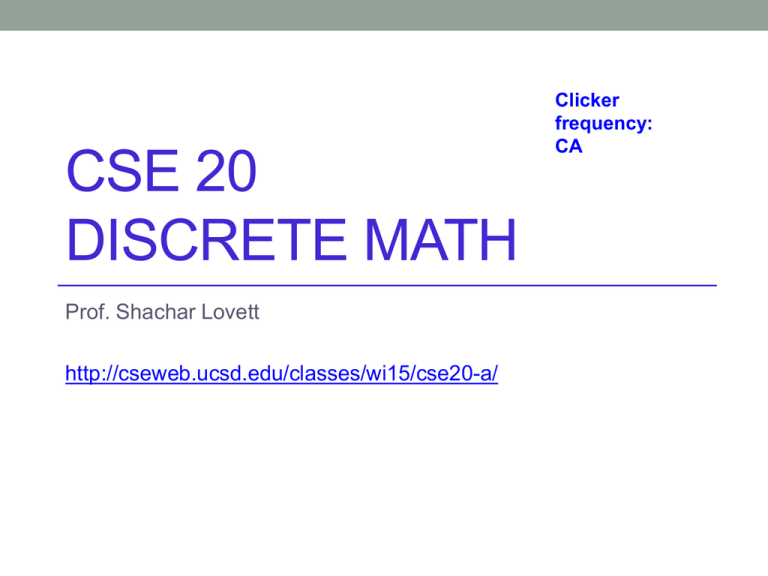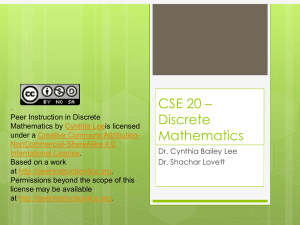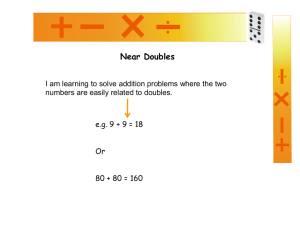slides
advertisement

CSE 20
DISCRETE MATH
Prof. Shachar Lovett
http://cseweb.ucsd.edu/classes/wi15/cse20-a/
Clicker
frequency:
CA
Todays topics
• Proof by induction:
• Set sizes equality
• Paying using 3 and 5 cent coins
• Section 3.6 in Jenkyns, Stephenson
Set sizes
• We saw last time the following theorem, useful to prove
that two sets have equal size
• Theorem: let X,Y be finite sets. Assume there is a function
𝑓: 𝑋 → 𝑌 which is both one-to-one and onto. Then |X|=|Y|.
• We will prove it using induction on |X|.
Set sizes
• Theorem: let X,Y be finite sets. Assume there is a function
𝑓: 𝑋 → 𝑌 which is both one-to-one and onto. Then |X|=|Y|.
• Prove by induction on n=|X|.
Set sizes
• Theorem: let X,Y be finite sets. Assume there is a function
𝑓: 𝑋 → 𝑌 which is both one-to-one and onto. Then |X|=|Y|.
• Prove by induction on n=|X|.
• Base case: n=0, so 𝑋 = ∅. If Y is not empty, then f is not
onto, so we must have Y = ∅ and hence |X|=|Y|=0.
Set sizes
• Theorem: let X,Y be finite sets. Assume there is a function
𝑓: 𝑋 → 𝑌 which is both one-to-one and onto. Then |X|=|Y|.
• Prove by induction on n=|X|.
• Base case: n=0, so 𝑋 = ∅. If Y is not empty, then f is not
onto, so we must have Y = ∅ and hence |X|=|Y|=0.
• Inductive step: assume it is true for all sets of size n.
Prove it is true when |X|=n+1.
Set sizes
Inductive step: let |𝑋| = 𝑛 + 1.
Choose 𝑥 ∗ ∈ 𝑋 and let 𝑦 ∗ = 𝑓 𝑥 ∗ ∈ 𝑌.
Define: 𝑋 ′ = 𝑋 ∖ {𝑥 ∗ }, 𝑌′ = 𝑌 ∖ {𝑦 ∗ }. We have 𝑋′ = 𝑛. We will prove that
𝑌 ′ = 𝑛 and hence 𝑌 = 𝑛 + 1.
First, we claim that ∀𝑥 ∈ 𝑋 ′ , 𝑓 𝑥 ∈ 𝑌 ′ . If this is false for some 𝑥 ∈ 𝑋 ′ , then
since 𝑓 𝑥 ∈ 𝑌 we must have 𝑓 𝑥 ∈ 𝑌 ∖ 𝑌 ′ = 𝑦 ∗ , so 𝑓 𝑥 = 𝑦 ∗ = 𝑓 𝑥 ∗
which is impossible since f is one-to-one.
So, we can define 𝑓 ′ : 𝑋 ′ → 𝑌 ′ by 𝑓 ′ 𝑥 = 𝑓 𝑥 . It is one-to-one because f is,
and is onto because they only element missing is 𝑓 𝑥 ∗ which is not in 𝑌’.
Hence we can apply the inductive assumption and conclude that 𝑌 ′ = 𝑛
and hence 𝑌 = 𝑛 + 1.
3-cent and 5-cent coins
• We will prove the following theorem
• Theorem: For all prices p ≥ 8 cents, the price p can be
paid using only 5-cent and 3-cent coins
1851-1889
1866-today
Thm: For all prices p ≥ 8 cents, the price p can be paid using only 5-cent and 3cent coins.
Proof (by mathematical induction):
Basis step: Show the theorem holds for price p=____.
Inductive step:
Assume [or “Suppose”] that
WTS that
So the inductive step holds, completing the proof.
Thm: For all prices p ≥ 8 cents, the price p can be paid using only 5-cent and 3cent coins.
Proof (by mathematical induction):
Basis step: Show the theorem holds for price p=________.
Inductive step:
Assume [or “Suppose”] that
WTS that
A.
B.
C.
D.
E.
So the inductive step holds, completing the proof.
0 cents
1 cent
2 cents
3 cents
Other/none/more
than one
Thm: For all prices p ≥ 8 cents, the price p can be paid using only 5-cent and 3cent coins.
Proof (by mathematical induction):
Basis step: Show the theorem holds for price p=8.
Inductive step:
Assume [or “Suppose”] that
WTS that
So the inductive step holds, completing the proof.
Thm: For all prices p ≥ 8 cents, the price p can be paid using only 5-cent and 3cent coins.
Proof (by mathematical induction):
Basis step: Show the theorem holds for price p=8.
Inductive step:
Assume [or “Suppose”] that
WTS that
A.
B.
C.
D.
E.
Theorem is true for p=8.
Theorem is true for some p>8.
Theorem is true for some p8.
Theorem is true for some p>0.
Theorem is true for all p>8.
So the inductive step holds, completing the proof.
Thm: For all prices p ≥ 8 cents, the price p can be paid using only 5-cent and 3cent coins.
Proof (by mathematical induction):
Basis step: Show the theorem holds for price p=8.
Inductive step:
Assume [or “Suppose”] that theorem is true for some p8.
WTS that
So the inductive step holds, completing the proof.
Thm: For all prices p ≥ 8 cents, the price p can be paid using only 5-cent and 3cent coins.
Proof (by mathematical induction):
Basis step: Show the theorem holds for price p=8.
Inductive step:
Assume [or “Suppose”] that theorem is true for some p8.
WTS that
A.
B.
C.
D.
Theorem is true for p=8.
Theorem is true for some p>8.
Theorem is true for p+1.
Theorem is true for p+8.
So the inductive step holds, completing the proof.
Thm: For all prices p ≥ 8 cents, the price p can be paid using only 5-cent and 3cent coins.
Proof (by mathematical induction):
Basis step: Show the theorem holds for price p=8.
Inductive step:
Assume [or “Suppose”] that theorem is true for some p8.
WTS that theorem is true for price p+1.
So the inductive step holds, completing the proof.
Thm: For all prices p ≥ 8 cents, the price p can be paid using only 5-cent and 3cent coins.
Proof (by mathematical induction):
Basis step: Show the theorem holds for price p=8.
Inductive step:
Assume [or “Suppose”] that theorem is true for some p8.
WTS that theorem is true for price p+1.
???
So the inductive step holds, completing the proof.
3-cent and 5-cent coins
• Inductive step:
• Assume price p8 can be paid using only 3-cent and 5-cent coins.
• Need to prove that price p+1 can be paid using only 3-cent and 5cent coins.
• Main idea: “reduce” from price p+1 to price p.
Making change
• If we have 100 5-cent coins, and 100 3-cent coins (for a
total of p = $8.00), how can we modify the number of 5cent and 3-cent coins so that we can make the p+1 price
(p+1 = $8.01)?
40 5-cent coins + 200 3-cent coins
B. 39 5-cent coins + 202 3-cent coins
C. 99 5-cent coins + 102 3-cent coins
A.
Making change
• If we have 100 5-cent coins, and 100 3-cent coins (for a
total of p = $8.00), how can we modify the number of 5cent and 3-cent coins so that we can make the p+1 price
(p+1 = $8.01)?
A. 40 5-cent coins + 200 3-cent coins
B. 39 5-cent coins + 202 3-cent coins
C. 99 5-cent coins + 102 3-cent coins
Turning our modification scheme into a
generic algorithm
• If we have n 5-cent coins, and m 3-cent coins (for a total
of p = 5n+3m), how can we modify the number of 5-cent
and 3-cent coins so that we can make the p+1 price (p+1
= 5n+3m+1)?
A. n+1 5-cent coins + m-2 3-cent coins
B. n-1 5-cent coins + m+2 3-cent coins
C. n+1 5-cent coins + m+2 3-cent coins
D. No generic way
Turning our modification scheme into a
generic algorithm
• If we have n 5-cent coins, and m 3-cent coins (for a total
of p = 5n+3m), how can we modify the number of 5-cent
and 3-cent coins so that we can make the p+1 price (p+1
= 5n+3m+1)?
A. n+1 5-cent coins + m-2 3-cent coins
B. n-1 5-cent coins + m+2 3-cent coins
C. n+1 5-cent coins + m+2 3-cent coins
D. No generic way
What if we don’t have any 5-cent coins to
subtract??
• If we have 0 5-cent coins, and m 3-cent coins (for a total
of p = 3m), how can we modify the number of 5-cent and
3-cent coins so that we can make the p+1 price (p+1 =
3m+1)?
A. You can’t
B. You can [explain to your group how]
What if we don’t have any 5-cent coins to
subtract??
• If we have 0 5-cent coins, and m 3-cent coins (for a total
of p = 3m), how can we modify the number of 5-cent and
3-cent coins so that we can make the p+1 price (p+1 =
3m+1)?
• Remove three 3-cent coins, add two 5-cent
• So: two 5-cent coins, m-3 3-cent points, for a total of
2*5+3*(m-3)=3m+1=p+1
That algorithm relies on being able to
subtract three 3-cent coins. What if we
don’t have that many? (only 1 or 2?)
A. Uh-oh, our proof can not work as we’ve done it so far
B. That could never happen [explain why not]
C. That could happen, and we need to make a 3rd (or
more) case(s) to handle it
Thm: For all prices p >= 8 cents, the price p can be paid using only 5-cent and
3-cent coins.
Proof (by mathematical induction):
Basis step: Show the theorem holds for p=8 (by example, e.g. p=3+5)
Inductive step:
Assume [or “Suppose”] that the theorem holds for some p8.
WTS that the theorem holds for p+1.
p8.
Assume that p=5n+3m where n,m0 are integers.
We need to show that p+1=5a+3b for integers a,b0.
Partition to cases:
Case I: n1. In this case, p+1=5*(n-1)+3*(m+2).
Case II: m3. In this case, p+1=5*(n+2)+3*(m-3).
Case III: n=0 and m2. Then p=5n+3m6 which is a
contradiction to p8.
So the inductive step holds, completing the proof.
We created an algorithm!
• Our proof actually allows us to algorithmically find a way
to pay p using 3-cent and 5-cent coins
• Algorithm for price p:
• start with x=8=3+5
• For x=8...p, in each step adjust the number of coins according to
the modification rules we’ve constructed to maintain price x
Algorithm pseudo-code
PayWithThreeCentsAndFiveCents:
Input: price p8.
Output: integers n,m0 so that p=5n+3m
1. Let x=8, n=1, m=1 (so that x=5n+3m).
2. While x<p:
a) x:=x+1
b) If n1, set n:=n-1, m:=m+2
c) Otherwise, set n:=n+2, m:=m-3
3. Return (n,m)
Algorithm pseudo-code
PayWithThreeCentsAndFiveCents:
Input: price p8.
Output: integers n,m0 so that p=5n+3m
1. Let x=8, n=1, m=1 (so that x=5n+3m).
2. While x<p:
a) x:=x+1
b) If n1, set n:=n-1, m:=m+2
c) Otherwise, set n:=n+2, m:=m-3
3. Return (n,m)
Invariant: x=5n+3m
Invariant: x=5n+3m
We proved that n,m0 in this process
always; this is not immediate from
the algorithm code
Algorithm run example
• 8=
• 9=
• 10 =
• 11=
• 12 =
x=8: n=1, m=1
While x<p:
Invariant: x=5n+3m
a) x:=x+1
b) If n1, set n:=n-1, m:=m+2
c) Otherwise, set n:=n+2, m:=m-3
Algorithm properties
• Theorem: Algorithm uses at most two nickels (i.e n2)
• Proof: by induction on p
• Try to prove it yourself first!
x=8: n=1, m=1
While x<p:
Invariant: x=5n+3m
a) x:=x+1
b) If n1, set n:=n-1, m:=m+2
c) Otherwise, set n:=n+2, m:=m-3
Algorithm properties
x=8: n=1, m=1
While x<p:
Invariant: x=5n+3m
a) x:=x+1
b) If n1, set n:=n-1, m:=m+2
c) Otherwise, set n:=n+2, m:=m-3
Theorem: Algorithm uses at most two nickels (i.e n2).
Proof: by induction on p
Base case: p=8. Algorithm outputs n=m=1.
Inductive hypothesis: p=5n+3m where n2.
WTS p+1=5a+3b where a2.
Proof by cases:
• Case I: n1. So p+1=5(n-1)+3(m+2) and a=n-12.
• Case II: n=0. So p+1=5*2+3(m-3). a=2.
In both cases p+1=5a+3b where a2. QED
Next class
• Strong induction
• Read section 3.6.1 in Jenkyns, Stephenson









